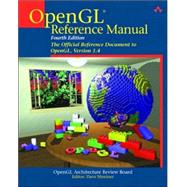
Dave Shreiner, a leading OpenGL consultant, was a longtime member of the core OpenGL team at SGI. He authored the first commercial OpenGL training course, and has been developing computer graphics applications for more than two decades.
| Preface | |
| What You Should Know Before Reading This Manual | |
| Style Conventions | |
| Acknowledgments | |
| Introduction to OpenGL | |
| OpenGL Fundamentals | |
| OpenGL Primitives and Commands | |
| OpenGL as a Procedural Language | |
| The OpenGL Execution Model | |
| Basic OpenGL Operation | |
| Overview of Commands and Routines | |
| The OpenGL Processing Pipeline | |
| Vertices | |
| ARB Imaging Subset | |
| Fragments | |
| Additional OpenGL Commands | |
| Using Evaluators | |
| Performing Selection and Feedback | |
| Using Display Lists | |
| Managing Modes and Execution | |
| Obtaining State Information | |
| OpenGL Utility Library | |
| Manipulating Images for Use in Texturing | |
| Transforming Coordinates | |
| Polygon Tessellation | |
| Rendering Spheres, Cylinders, and Disks | |
| NURBS Curves and Surfaces | |
| Handling Errors | |
| OpenGL Extension to the X Window System | |
| Initialization | |
| Controlling Rendering | |
| Summary of Commands and Routines | |
| Notation | |
| OpenGL Commands | |
| Primitives | |
| Vertex Arrays | |
| Coordinate Transformation | |
| Coloring and Lighting | |
| Clipping | |
| Rasterization | |
| Pixel Operations | |
| Textures | |
| Fog | |
| Frame Buffer Operations | |
| Evaluators | |
| Selection and Feedback | |
| Display Lists | |
| Modes and Execution | |
| State Queries | |
| ARB Extensions | |
| Imaging Subset | |
| GLU Routines | |
| Texture Images | |
| Coordinate Transformation | |
| Polygon Tessellation | |
| Quadric Objects | |
| NURBS Curves and Surfaces | |
| State Queries | |
| GLX Routines | |
| Initialization | |
| Controlling Rendering | |
| Defined Constants and Associated Commands | |
| OpenGL Reference Pages | |
| GLU Reference Pages | |
| GLX Reference Pages | |
| Table of Contents provided by Publisher. All Rights Reserved. |
The New copy of this book will include any supplemental materials advertised. Please check the title of the book to determine if it should include any access cards, study guides, lab manuals, CDs, etc.
The Used, Rental and eBook copies of this book are not guaranteed to include any supplemental materials. Typically, only the book itself is included. This is true even if the title states it includes any access cards, study guides, lab manuals, CDs, etc.